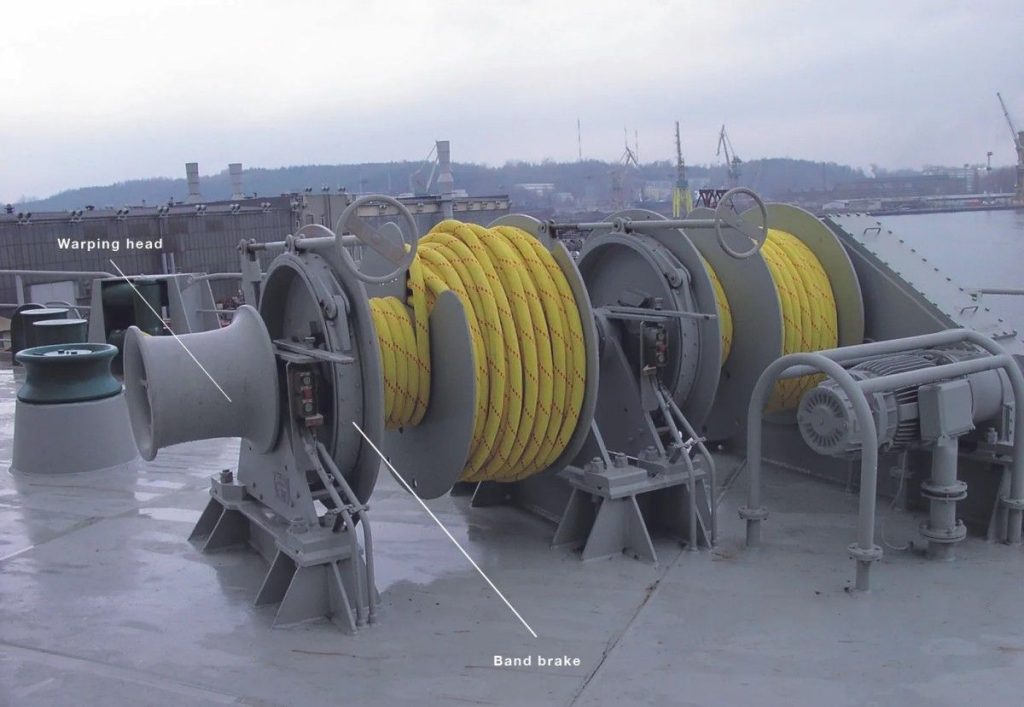Mooring winches are an essential piece of equipment used in maritime industries to secure a vessel to a dock or another fixed structure. These winches play a critical role in ensuring the safety of ships during mooring operations by controlling the tension and movement of the mooring lines. In this detailed guide, we will explore the functions, types, and advantages of mooring winches, highlighting how they contribute to efficient and secure vessel mooring.

What is a Mooring Winch?
A mooring winch is a specialized winch designed to handle the mooring lines that connect a ship to a dock or berth. It is equipped with drums that wind and unwind the mooring ropes or wires, allowing for precise control over the vessel’s positioning during docking or undocking. Mooring winches are essential for maintaining tension on the mooring lines to keep the vessel securely in place, especially during adverse weather conditions.
Key Components of a Mooring Winch:
- Drums: The main component where mooring lines are wound. Some winches have multiple drums for handling multiple lines.
- Brakes: Critical for controlling the release of tension and ensuring the line remains secure.
- Controls: Operators use manual or electronic controls to manage the winch’s functions, such as tightening or loosening lines.
Types of Mooring Winches
Mooring winches come in various types, each suited for different operational needs and vessel sizes. The primary types include:
1. Electric Mooring Winches
Electric mooring winches are powered by electric motors, making them a popular choice due to their ease of use and energy efficiency. These winches offer reliable control and are often used on small to medium-sized vessels.
Key Benefits:
- Energy Efficient: Electric winches consume less energy compared to other types, reducing operational costs.
- Low Maintenance: These winches require less maintenance, making them a cost-effective solution.
- Precise Control: Operators can easily adjust the speed and tension of the mooring lines for better control.
2. Hydraulic Mooring Winches
Hydraulic mooring winches are powered by hydraulic systems, providing greater power and control for larger vessels. These winches are suitable for heavy-duty mooring operations that require higher pulling force and speed.
Key Benefits:
- High Power Output: Ideal for larger vessels that require significant pulling force.
- Durability: Hydraulic winches are highly durable, designed to withstand tough marine environments.
- Smooth Operation: Hydraulic systems allow for smoother and more gradual control of line tension.
3. Manual Mooring Winches
Manual mooring winches are operated by hand, making them suitable for small vessels and less demanding mooring situations. Although less common in modern vessels, they are still used in specific cases where power systems are not available.
Key Benefits:
- Cost-Effective: Manual winches are the most affordable option, requiring no external power source.
- Simplicity: Easy to operate with minimal training required.
- Lightweight: Ideal for smaller boats and vessels.
Advantages of Mooring Winches

Mooring winches offer several key advantages that contribute to the safety and efficiency of mooring operations. Some of the most notable benefits include:
1. Enhanced Safety
Mooring winches provide precise control over the tension in mooring lines, reducing the risk of sudden line failures or accidents. With advanced braking systems and tension control features, mooring winches ensure the vessel remains securely anchored, even in rough seas or high winds.
2. Increased Efficiency
By automating the process of tightening and loosening mooring lines, winches significantly reduce the time and labor required for mooring operations. This efficiency is particularly important in busy ports where time is a critical factor.
3. Durability and Reliability
Mooring winches are built to withstand the harsh conditions of marine environments. Their robust construction ensures long-lasting reliability, minimizing downtime and maintenance costs.
4. Adaptability to Different Vessels
Mooring winches come in various sizes and power capacities, making them suitable for different types of vessels, from small boats to large ocean-going ships. This adaptability ensures that mooring winches can meet the specific needs of any vessel or port operation.
Diagram: Functioning of a Mooring Winch System

Choosing the Right Mooring Winch for Your Vessel
Selecting the right mooring winch depends on several factors, including the size of your vessel, the type of mooring operations, and the environmental conditions in which you operate. For smaller vessels, an electric or manual mooring winch may be sufficient, while larger ships may require the power and durability of a hydraulic winch.
Considerations for Selection:
- Vessel Size: Larger vessels require more powerful winches to handle heavier loads.
- Operational Environment: Consider the weather and sea conditions where the vessel will be moored.
- Power Source Availability: Ensure the availability of electricity or hydraulic systems on your vessel.
Conclusion
Mooring winches are a critical component of safe and efficient vessel mooring. Whether you need the energy efficiency of an electric winch, the power of a hydraulic winch, or the simplicity of a manual winch, choosing the right type of mooring winch ensures that your vessel is securely anchored in all conditions. With their advanced control systems and durable construction, mooring winches provide a reliable solution for any maritime operation.